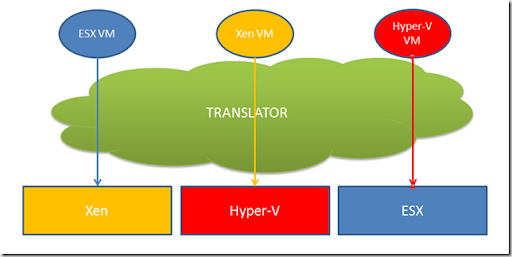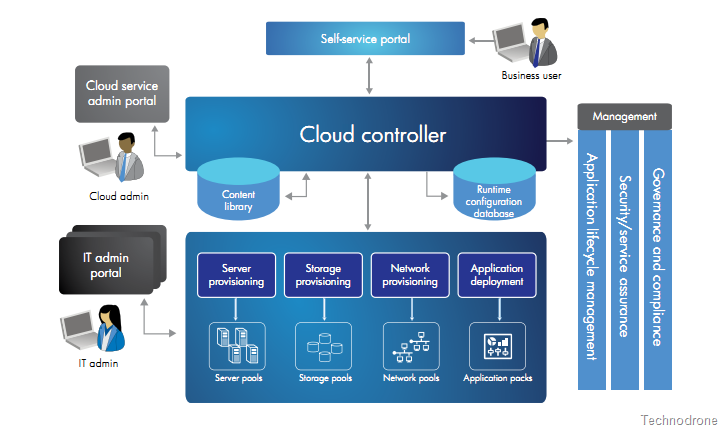Orchestration Will Rule Them All BRC2K11
On Wednesday night I participated on session 2 of the Blogger Reality Contest. From the rankings that were published on Wednesday - I am actually not doing so well (so your continued and strengthened support would be appreciated) - but hey this is not about the competition - it is all about the participation. It is great to interact with a whole new set of people, and I am sure that the relationships built during these three weeks will last. But let’s get back to the technology part of it.
Wednesday’s topic was Converged Systems. I will not bother you all again with the converged part, we covered that all last week, and the three topics covered were:
- HP VirtualSystem
- HP CloudSystem
- HP AppSystems
The one I would like to cover here in more detail is HP CloudSystem. A while back I wrote a post about The Datacenter - in a Few Years From Now where I presented this graphic below.
 The relevant part I think is the one here below
The relevant part I think is the one here below
And what does this have to with cloud though? The way I see cloud vision is having your pool of resources from which you can provision your applications and vApps to your end users. At the moment this is limited to a cloud for each Hypervisor. I cannot have a VMware vCloud that has Hypervisors that are not ESX. I cannot have a Microsoft Cloud with Hypervisors that are not Hyper-V and so on.. Yes, there are some products that will allow you to manage the multiple clouds under one “umbrella” and place the VM in your Hyper-V cluster or ESX Cluster or RHV Cluster according to different criteria. But today they still need to be separate clusters. Utilizing such an idea will make my infrastructure completely vendor agnostic - and I (the customer) could pick and choose whichever hypervisor suits me.
VMware has their cloud product - vCloud Director. Microsoft has their Private Cloud, Redhat has their CloudForms, Citrix has their Project Olympus. The purpose of this post is, not to get into who has the best cloud offering, nor who has the more mature product. The reality of today is that most infrastructures are running mainly on one platform, and one platform only. Will that change in the future? I think so - in my post Why Should you Care about Veeam Support for Hyper-V, I started to talk about the market share that other hypervisors are gaining and will continue to do so in the future.
I spent a hour on a conference call last week with a colleague who had built their own private cloud solution. I was interested in hearing the details behind the platform and how it was built, and I was quite surprised to actually hear that the whole infrastructure was built on VMware - but they had decided on a 3rd party solution for the orchestration of the the cloud and not to use vCloud Director. The reason being mainly because of the lack of integration the system actually has into current business process. The amount of time it actually takes to integrate into their current CMDB, and a number of other reasons as well. Looking back on the conversation I actually am starting to see that the above graphic that I made should actually be changed. A layer that translates the operations from kind of hypervisor to the other will not actually be the correct solution or the right way to go.
The way to actually go would be to create a system that would allow you to manage Hypervisors/Clouds from multiple vendors, all under one management portal. This way you as the Admin
would still not care if the machine is running on a VMware / Hyper-V / Xen / Redhat cluster - for you the machine will be managed the same way regardless. The Orchestration software will be that to deploy the virtual machine according to your pre-defined criteria of cost / SLA etc. and present a unified interface to the end-user so they will be able to access their machine - again completely ambivalent to the what the underlying hypervisor is.
HP CloudSystem could be such a platform. Providing a layer of automation that is external to the the actual hypervisor - could actually be the answer. Treating Server / Storage / Network / Application Pools as exactly that - just pools - and to the end-business user who does not care what platform they run on - but rather that they work, this abstraction should work just fine.
You could even take this one level further by adding an external public cloud to your pool of services. Something like Cloudbursting.
Cloudbursting is an application hosting model which combines existing corporate infrastructure with new, cloud-based infrastructure to create a powerful, highly scalable application hosting environment.
To explain this in my terms, you use the public cloud as an extension of your compute resources to extend and scale as needed for your application.
The HP CloudSystem core is built on the HP BladeSystem architecture and includes the Matrix Operating Environment that enables rapid provisioning of complex infrastructure services and adjustment of those services to meet changing business demands. It also includes HP Cloud Service Automation software to manage the entire cloud lifecycle. Cloud Service Automation provisions applications, manages and monitors the cloud, and provides a single service view across the cloud and traditional IT.
HP CloudSystem’s core capabilities can be extended with
• Cloud Maps: tools and best practices that enable CloudSystem to quickly and easily provision various kinds of common application environments from major vendors such as VMware, Oracle, SAP, and Microsoft. Cloud Maps can substantially reduce the time and effort needed to deploy CloudSystem services.
- HP storage
- HP networking
- HP Software
To sum up this post - The future of the cloud (and your datacenter) will be in the automation layer and will look something like this. It will all lie in the orchestration layer.
As this is a contest your vote does count. Please add you vote in box below. Thanks. Your comments of course are always welcome.
I Liked the post - Blogger Reality Show Week 2
(Small Print) HP is not the only one to offer such software or orchestration platforms. There are several other vendors and other 3rd party companies that provide the same or similar technologies. HP is one of the sponsors of this event, which mean they are partially footing the bill for my trip to VMworld this month. I am highly grateful for the opportunity and honor but I am under no obligation to write anything positive (or negative for that matter) about any of the presented solutions. The opinions and thoughts above are my own so take them as they are.



